Mexico: The Good, The Bad, And The Hopeful
Mexico: The Good, The Bad, And The Hopeful
By Julie Webb-Pullman
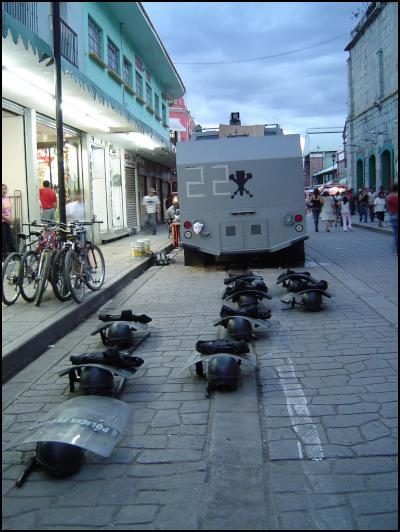
Click for big version
Mexican Police In The Oaxaca Zocala
THE GOOD
Federal District
Mexican Attorney General Daniel Cabeza de Vaca on Monday backed down from his refusal to accept the recommendations of the National Commission on Human Rights in relation to the torture of Jesús Zúniga Velázquez, following criticism from the Geneva Committee Against Torture, several meetings with Mexican Ombudsman José Luis Soberanes – and perhaps a little international press exposure, courtesy of SCOOP!
Montes Azules
As corrected, the death toll from the Montes Azules attack in Chiapas has been revised down from eleven to four. However, some 50 women and children from local communities have since fled to San Cristóbal de Las Casas to take refuge, reporting that there are still people missing, and the death toll could yet be between 9 and 15. Local and international human rights groups have demanded authorities conduct a full, prompt, and impartial investigation into the violent confrontations, in which members of the security forces are alleged to have participated.
Oaxaca
- Unidentified Bodies
The pile of unidentified bodies reported to have been dumped at the Red Cross have been explained as overflow from the hospital, whose morgue was full. The team of investigators designated by the APPO to examine the bodies was made to wait for three hours before being permitted entry, leading to suspicion that some bodies may have been removed during the wait. The 24 they examined exhibited no signs of violent death, and no bullet wounds, so it is assumed they were not victims of government gunmen. An effort is now underway to identify them from facial photos and body markings, which will also be compared with unauthorised video and other photographs taken before the investigation team arrived.
- Photographers Released
Two Oaxaqueño men snatched around 3.30 pm on 15 November while taking photographs in the Zocalo were released later that night following the intervention of human rights workers. The men had been taking photos (probably similar to these I took a few days earlier during the APPO congress) when members of the PFP encircled them, kicked and beat them to the ground, then took them away in a vehicle. Onlookers noted the license plates and a woman reported the incident to the Plantón, from where it was followed up, resulting in their comparatively rapid release.
- APPO Congress
More than three thousand delegates from neighbourhood, political and social organisations attended the congress of the Asamblea Popular de Pueblos de Oaxaca (Popular Assembly of the Peoples’ of Oaxaca, or APPO) between November 10 and 13, which saw the transformation of APPO into the State Council of the Popular Assembly of the Peoples of Oaxaca (CEAPPO, in its Spanish initials), which will create a new constitution for Oaxaca. CEAPPO’s 260 representatives undertake to pursue social and economic justice, equality, respect for differences, women’s rights, and indigenous people and their autonomy, and sustainable development concerned with renewable resources which will benefit all Oaxaqueños. Their plan of action thus inevitably includes the ousting of Governor Ulises Ruiz and the PFP from Oaxaca.

Click for big version
Mexican Police In The Oaxaca Zocala
- Sierra Juárez
150 Indian communities of the Sierra Juárez area on Sunday resolved to constitute themselves into the Assembly of the Peoples of Zapotecos, Mixes and Chinantecos to take the fight against Ruiz into the most remote regions of this extensive mountain range. The municipal head, organizations and citizens of the four districts of the region selected 24 people to represent them in APPO, to undertake “radical but peaceful” means to overthrow governor Ulises Ruiz. Among their first actions is to participate in the march on 25 November to Oaxaca to surround the PFP in the Zócalo, and for their community radio stations to assume the transmission of information that Radio Universidad is now being prevented from transmitting.
- University Reopens
The Soriana blocklade in University Avenue was removed on Tuesday to enable classes to resume at the Benito Juárez Autonomous University of Oaxaca, although the Cinco Señores blockade remains in place. Students made it clear that the fact that they have accepted the removal of that blockade does not imply in any way that they have given up their demand for the exit of Governor Ulises Ruiz Ortiz.
Atenco
Numerous irregularities have been found in the evidence against the 30 prisoners still detained from Texcoco and Atenco, sufficient to order their immediate release, according to the team of lawyers. They have identified invalid depositions by police, contradictory police depositions that prove that head of the FPDT Ignacio de Valle could not possibly have taken part in the kidnapping of police in Atenco as he was in police custody in Texcoco at the time, evidence proving police provided false information in relation to theft of their identity cards, and they identified several identical statements by individual police, including with identical spelling mistakes. Whether this will be ‘good’ enough for the dubious judge to release the prisoners on bail at least, remains to be seen.
THE BAD
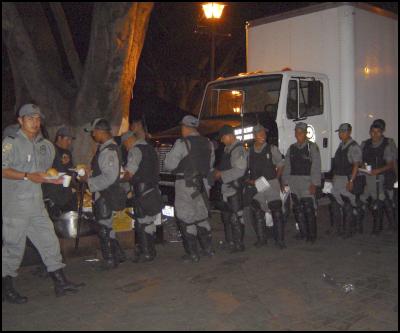
Click for big version
Mexican Police In The Oaxaca Zocala
Oaxaca
Governor Ruiz and his corrupt administration this week tried to pin the blame for the murder of US independent journalist Brad Will on APPO. The Oaxaca State Attorney General held a news conference in which it was claimed they had new facts and evidence which proves that Brad was shot twice at close range from the same gun, 20 minutes apart, after being threatened by voices next to him. Neither the audio of the tape Brad was filming at the time of his death nor the original unedited coroner's report, which found that the two 9mm bullets that hit Brad were fired from a distance of at least 45 meters (50 feet), and that the one that hit him in the sternum caused death within minutes, support the Attorney-General’s spurious claims. Copies of the original coroner’s report are in the hands of the US Embassy and the Mexican National Human Rights Commission, and Brad’s camera and original tape are safe in the hands of his family in the United States. No forensic evidence has been presented to date to substantiate the State government’s claims, and in light of the existing evidence it is considered that any such government ‘evidence’ would be fake.
- Women’s March
Following the sexual assault of a woman by a member of the PFP on 18 November, a peaceful women’s protest on Sunday, during which a play was performed and mirrors bearing the words ‘rapists’ and ‘traitors’ were held before the faces of the PFP, was met with a spray of ‘chile water’, resulting in several people requiring medical treatment.
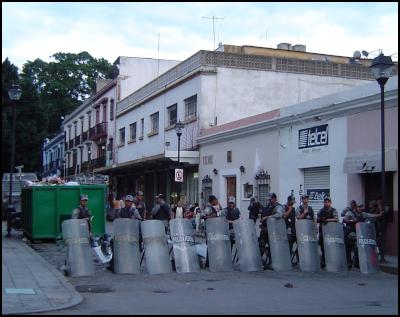
Click for big version
Mexican Police In The Oaxaca Zocala
- Santo Domingo Plantón Burnt Down
At dawn the next morning a group of about 40 armed people in civilian clothing attacked and burned down the APPO camp in Santo Domingo Plaza, symbolic bastion of resistance for 20 days, in a fire which lasted 20 minutes and which, despite the efforts of neighbours with buckets of water, destroyed everything. Several people had been sleeping in the camp at the time of the attack.
- Mexican Revolution Anniversary March violence
Later that day, an hour and a half into a peaceful march to celebrate the anniversary of the Mexican Revolution there commenced a four-hour pitched battle between PFP and APPO sympathisers, resulting in 53 marchers injured, at least three of them receiving serious head injuries. The battle is reported in La Jornada to have begun when one of the police threw a stone causing a head injury to a marcher, to which other marchers responded by throwing plastic bottles and stones. The PFP then used ‘tear gas’ to attempt to disperse the march. The agent used, CS gas, is in fact a chemical warfare agent banned by the Geneva Convention for use in war (but apparently not for use on civilian populations) because of its carcinogenic, teratogenic, mutagenic, and other toxic effects on the human body. Media to also suffer at the hands of the PFP included La Jornada photographer Francisco Olvera who was pursued by armed police agents, Efe and Reuters photographers Patricia Domínguez and Jorge Luis Silver and TV Aztec cameraman Alejandro Domínguez Juárez who were attacked by elements of the PFP, and The Universal reporter Alejandro Torres, who was hit in the leg by a ‘tear gas’ canister. 15 marchers were detained by the PFP, but following negotiations, seven were released.
Atenco
- Human Rights
Another attempt at a human rights whitewash - Alejandro Carmona, head of the Mexican prison system, exonerated the director of Santiaguito Prison, whom the National Commission of Human Rights (CNDH) identified as responsible for altering evidence supporting the allegations of ill-treatment by 26 of the 40 women detained in the operation of San Salvador Atenco and Texcoco on 3 and 4 May. He said the women washed their own clothes. Carmona also refuted that the detainees were denied medical treatment, saying there is documentary evidence of what medications they were given. These elements form part of the denial by the Mexican Directorate of Social Readjustment to the State Government, that elements of the police committed torture, as found by the CNDH.
- Double Trouble
The Mexico State Government reactivated 52 charges against members of the Front of Peoples in Defense of the Earth (FPDT) of San Salvador Atenco. 150 members of FPDT marched on Monday in the Texcoco-Lechería highway in protest at the reactivation against 300 of their members of common law charges that had been in reservation since 2002 in relation to mobilisations rejecting the construction of a new airport.
THE HOPEFUL
Lopez Obrador Inaugurated as Legitimate President
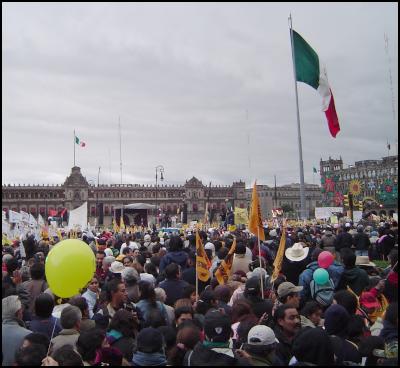
Click for big version
Andrés Manuel López Obrador (AMLO) in the Zocalo in Mexico City
Between 100,000 and 300,000 people crowded the Zócalo in Mexico City on Monday to support the inauguration of Andrés Manuel López Obrador (AMLO as he is popularly known) as the legitimate President of Mexico. In freezing temperatures, entire families braved the cold and the crowds to sing, chant, and scream their support for the President they believe was denied his rightful office through fraudulent elections. AMLO committed to protect the rights of the people, to defend Mexican heritage and national sovereignty, and to embark on the profound transformation that the country is demanding.
He announced a 20 point programme of action, beginning with an overhaul of public institutions, defending and opening up access to information, addressing the grave migration problems, and a host of legal and constitutional initiatives to combat corruption, foreign exploitation, to protect the environment and the interests of the poor and of indigenous peoples. Health, education and unions are also on the agenda, in a raft of measures that a La Jornada editorial concluded are “common sense measures to repay the enormous social, economic and political debt owed to millions of Mexicans” systematically wronged by existing formal institutions and officials. Rather than Obrador’s parallel presidency, “The marginalisation and misery of these people, and the insatiable ambition of huge national and foreign capital, constitute the real challenge to stability and peace in this country,” La Jornada concluded.
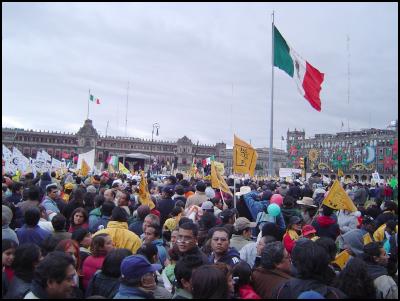
Click for big version
Andrés Manuel López Obrador (AMLO) in the Zocalo in Mexico City
Bishop of the Diocese of Saltillo, Raúl Vera López, echoed these sentiments, saying that the inauguration of Obrador obeyed a social call, rather than a personal whim, and that in the face of what many believe was electoral fraud, AMLO represents the moral authority of the Mexican people. Vera likened the times to those of the Zapatista uprising in 1994, when “Subcomandante Marcos didn't make the rebellion alone, but rather it was rooted in the dissent of a people that was tired, excluded, damaged and ill-treated. At that time there were two armies, the official one and the one that represented the social calls, like now there will be two presidents." Adrián Ramírez, president of the Mexican League for the Defence of Human rights, agreed with the La jornada editorial that Obrador’s inauguration reflects a lack of transparency in the decisions of the Electoral Federal Institute and the Electoral Tribunal of the Judiciary of the Federation, and their inability and/or lack of will to conduct a reliable recount of the votes.
As La Jornada pointed out, national dislocation and the untenable circumstances that the country has been placed by the political-managerial alliance in power, are a result of “economic policies that deepened inequalities...of tolerated social injustices fomented by the ruling group, of a closeness and a political blindness that distorted democratic processes, and of a managerial voracity that openly trampled the institutional order of the country.” It is a deep division between the interests of big business determined to conserve their privileges and the circumstances favourable for their domestic pillaging, and the many millions of excluded Mexicans. Edgar Cortez, executive secretary of the network All Rights for All, considered the measure of Obrador "which is not just a whim, but a political position", will be in the degree that he is able to maintain his moral authority and capacity in relation to these crucial domestic issues.
Asemblea Popular de los Pueblos de Mexico (APPM)
The deep cynicism regarding ALL politicians and political parties means the people are not holding their breath. With the endorsement of 19 popular state assemblies and 75 social organisations, the Popular Assemble of the People of Mexico, APPM, was formally constituted on Sunday in Mexico City. Jorge Ramos Avilés, one of the organizing commission of the APPM, told a press conference that this social movement represents “the greatest possibility of change for the country”, being born out of the heroic struggle of the people of Oaxaca. Chair of the plenary debates Jacqueline Lopez emphasised that the APPM is an independent entity that will operate outside of the political parties, and will act as the power of the people.
Among its objectives, she said, are to unify the people of Mexico through the organization of fronts that, integrated in a single force, have the capacity to confront the power of the extreme right, represented in the government of Calderón and the neoliberal policies it tries to impose. Argelia Ayala, representative of the Unión Popular Revolucionaria Emiliano Zapata, assured that the APPM will be open to all peoples’ forces and organisations prepared to participate “beyond their political or partisan connections”, embodying a new form of policy-making where decisions and participation directly involve all citizens.
Samuel Hernandez, member of the APPO, stressed that confronted with a neoliberal model that threatens “not only the natural resources of the country, but also the ancestral forms of culture of our peoples”, social and popular organization are the only alternative to make their voices heard. He emphasised that they are all participating in the construction of an alternative project with respect to political dynamics that will allow a deep transformation of the country, because “today more than ever we are convinced that the hour of the people has arrived.” As one of its first moves, the constituent assembly decided to totally support the plan of action of the APPO, and to participate in the megamarch to Oaxaca on 25 November. Provisional commissions were created that will be in charge of organizing the APPM throughout the country and convoking a first constituent congress, to consolidate the movement on a national scale.
Clearly, while members of Obrador’s PRD party are welcome to participate in this broad-based social movement, they will neither drive nor control it, and his survival as a force in Mexican social and political life will depend entirely on his ability to follow the example of the Zapatistas and the demands of the Mexican people, and ‘govern by obeying’.
ENDS


 Gordon Campbell: On The West’s War Against Iran
Gordon Campbell: On The West’s War Against Iran Binoy Kampmark: Condemning The Right To Self-Defence - Iran’s Retaliation And Israel’s Privilege
Binoy Kampmark: Condemning The Right To Self-Defence - Iran’s Retaliation And Israel’s Privilege Gordon Campbell: On The Making Of King Donald
Gordon Campbell: On The Making Of King Donald Binoy Kampmark: Rogue States And Thought Crimes - Israel Strikes Iran
Binoy Kampmark: Rogue States And Thought Crimes - Israel Strikes Iran Eugene Doyle: The West’s War On Iran
Eugene Doyle: The West’s War On Iran Richard S. Ehrlich: Deadly Border Feud Between Thailand & Cambodia
Richard S. Ehrlich: Deadly Border Feud Between Thailand & Cambodia